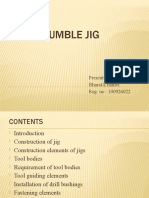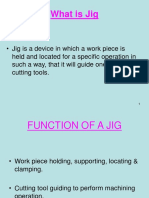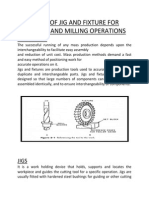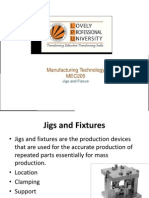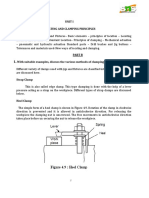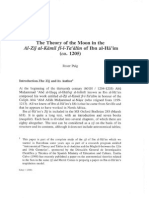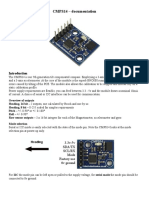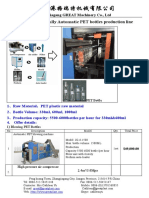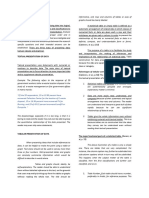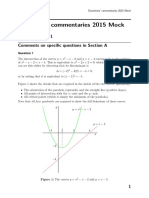0 ratings0% found this document useful (0 votes)
357 viewsClamping Method in Jigs and Fixture
Clamping Method in Jigs and Fixture
Uploaded by
nilamThis document discusses guidelines for selecting clamps in jigs and fixtures. It describes how clamps are used to hold workpieces against locators and prevent movement during machining operations. The key factors discussed for selecting appropriate clamps include resisting secondary cutting forces without damaging the workpiece, handling vibration and stress, and improving loading/unloading speed while avoiding interference with machine tools. Positioning clamps over locators and at rigid points on the workpiece is also recommended.
Copyright:
© All Rights Reserved
Available Formats
Download as PPT, PDF, TXT or read online from Scribd
Clamping Method in Jigs and Fixture
Clamping Method in Jigs and Fixture
Uploaded by
nilam0 ratings0% found this document useful (0 votes)
357 views15 pagesThis document discusses guidelines for selecting clamps in jigs and fixtures. It describes how clamps are used to hold workpieces against locators and prevent movement during machining operations. The key factors discussed for selecting appropriate clamps include resisting secondary cutting forces without damaging the workpiece, handling vibration and stress, and improving loading/unloading speed while avoiding interference with machine tools. Positioning clamps over locators and at rigid points on the workpiece is also recommended.
Original Description:
Clamping Method in Jigs and Fixture
Copyright
© © All Rights Reserved
Available Formats
PPT, PDF, TXT or read online from Scribd
Share this document
Did you find this document useful?
Is this content inappropriate?
This document discusses guidelines for selecting clamps in jigs and fixtures. It describes how clamps are used to hold workpieces against locators and prevent movement during machining operations. The key factors discussed for selecting appropriate clamps include resisting secondary cutting forces without damaging the workpiece, handling vibration and stress, and improving loading/unloading speed while avoiding interference with machine tools. Positioning clamps over locators and at rigid points on the workpiece is also recommended.
Copyright:
© All Rights Reserved
Available Formats
Download as PPT, PDF, TXT or read online from Scribd
Download as ppt, pdf, or txt
0 ratings0% found this document useful (0 votes)
357 views15 pagesClamping Method in Jigs and Fixture
Clamping Method in Jigs and Fixture
Uploaded by
nilamThis document discusses guidelines for selecting clamps in jigs and fixtures. It describes how clamps are used to hold workpieces against locators and prevent movement during machining operations. The key factors discussed for selecting appropriate clamps include resisting secondary cutting forces without damaging the workpiece, handling vibration and stress, and improving loading/unloading speed while avoiding interference with machine tools. Positioning clamps over locators and at rigid points on the workpiece is also recommended.
Copyright:
© All Rights Reserved
Available Formats
Download as PPT, PDF, TXT or read online from Scribd
Download as ppt, pdf, or txt
You are on page 1of 15
At a glance
Powered by AI
The key takeaways are that clamps are used to hold workpieces in place during machining operations and factors like vibration, forces, speed, and avoiding damage to the workpiece must be considered when selecting clamps.
The primary functions of clamps are to hold the workpiece against locators and prevent movement of the workpiece during machining operations.
Factors that should be considered when selecting clamps include the forces expected in the operation, vibration levels, clamping speed, and preventing damage to the workpiece.
CLAMPING METHOD IN
JIGS AND FIXTURE
CLAMPING GUIDELINES
Locating the workpiece is the first basic
function of a jig or fixture. Once located,
the workpiece must also be held to
prevent movement during the operational
cycle. The process of holding the position
of the workpiece in the jig or fixture is
called clamping.
The primary devices used for holding a
workpiece are clamps
Factors in Selecting Clamps
Clamps serve two primary functions. First,
they must hold the workpiece against its
locators. Second, the clamps must prevent
movement of the workpiece. The locators,
not the clamps, should resist the primary
cutting forces generated by the operation.
Holding the Workpiece Against Locators
. Clamps are not intended to resist the
primary cutting forces. The only purpose
of clamps is to maintain the position of
the workpiece against the locators and
resist the secondary cutting forces. The
secondary cutting forces are those
generated as the cutter leaves the
workpiece. In drilling, for example, the
primary cutting forces are usually
directed down and radially about the axis
of the drill. The secondary forces are the
forces that tend to lift the part as the drill
breaks through the opposite side of the
part. So, the clamps selected for an
application need only be strong enough
to hold the workpiece against the locators
and resist the secondary cutting forces
Holding Securely Under Vibration,
Loading, and Stress
Holding Securely Under
Vibration, Loading, and
Stress. The next factors in
selecting a clamp are the
vibration and stress
expected in the operation.
Cam clamps, for example,
although good for some
operations, are not the
best choice when
excessive vibration can
loosen them. It is also a
good idea to add a safety
margin to the estimated
forces acting on a clamp.
Preventing Damage to the Workpiece.
The clamp chosen must also
be one that does not damage
the workpiece. Damage
occurs in many ways. The
main concerns are part
distortion and marring. Too
much clamping force can
warp or bend the workpiece.
Surface damage is often
caused by clamps with
hardened or non-rotating
contact surfaces. Use clamps
with rotating contact pads or
with softer contact material to
reduce this problem. The best
clamp for an application is
one that can adequately hold
the workpiece without surface
damage.
Improving Load/Unload Speed
The speed of the
clamps is also important
to the workholder's
efficiency. A clamp with
a slow clamping action,
such as a screw clamp,
sometimes eliminates
any profit potential of
the workholder. The
speed of clamping and
unclamping is usually
the most-important
factor in keeping
loading/unloading time
to a minimum.
Positioning the Clamps
The position of clamps on the workholder is just
as important to the overall operation of the tool
as the position of the locators. The selected
clamps must hold the part against the locators
without deforming the workpiece. Once again,
since the purpose of locators is to resist all
primary cutting forces generated in the operation,
the clamps need only be large enough to hold
the workpiece against the locators and to resist
any secondary forces generated in the operation
o meet both these
conditions, position the
clamps at the most-rigid
points of the workpiece.
With most workholders,
this means positioning the
clamps directly over the
supporting elements in the
baseplate of the workholder,
Figure-3-23a
In some cases the
workpiece must be clamped
against horizontal locators
rather than the supports,
Figure 3-23b. In either case,
the clamping force must be
absorbed by the locating
elements.
For workholders
with two supports
under the
clamping area of
the workpiece, two
clamps should be
used — one over
each support,
Another consideration in positioning clamps
is the operation of the machine tool
throughout the machining cycle. The clamps
must be positioned so they do not interfere with
the operation of the machine tool, during either
the cutting or return cycle. Such positioning is
especially critical with numerically controlled
machines. In addition to the cutters, check
interference between the clamps and other
machine elements, such as arbors, chucks,
quills, lathe carriages, and columns.
When fixturing an automated machine, check
the complete tool path before using the
workholder. Check both the machining cycle
and return cycle of the machine for interference
between the cutters and the clamps.
Occasionally programmers forget to consider the
tool path on the return cycle. One way to reduce
the chance of a collision and eliminate the need
to program the return path is simply to raise the
cutter above the highest area of the workpiece
or workholder at the end of the machining cycle
before returning to the home position.
Most clamps are
positioned on or near the
top surface of the
workpiece. The overall
height of the clamp, with
respect to the workpiece,
must be kept to a
minimum. This can be
done with gooseneck-type
clamps, Figure 3-25. As
shown, the gooseneck
clamp has a lower profile
and should be used where
reduced clamp height is
needed.
The workpiece shown in Figure 3-26 illustrates
this point. The part is a thin-wall ring that must
be fixtured so that the internal diameter can be
bored. The most-convenient way to clamp the
workpiece is on its outside diameter; however,
to generate enough clamping pressure to hold
the part, the clamp is likely to deform the ring.
The reason lies in the direction and magnitude
of the clamping force: rather than acting
against a locator, the clamping forces act
against the spring force of the ring resisting the
clamping action. This type of clamping should
only be used if the part is a solid disk or has a
small-diameter hole and a heavy wall thickness.
To clamp this type of part, other techniques
should be used. The clamping arrangement in
Figure 3-27 shows the workpiece clamped with
four strap clamps. The clamping force is
directed into the base plate and not against the
spring force of the workpiece. Clamping the
workpiece this way eliminates the distortion of
the ring caused by the first method.
If the part can be
clamped only on its
outside surface, one
other method can be
used to hold the part:
a collet that
completely encloses
the part. As shown
You might also like
- Tumble Jig: Presented by Bharat.k.manvi Reg No: 100926022Document29 pagesTumble Jig: Presented by Bharat.k.manvi Reg No: 100926022Bharat ManviNo ratings yet
- DassdafDocument15 pagesDassdafEdmar Bataque100% (1)
- AQA Chemistry Atomic Structure and The Periodic Table KnowIT GCSEDocument86 pagesAQA Chemistry Atomic Structure and The Periodic Table KnowIT GCSEMazanda YalinduaNo ratings yet
- AWWA M45 2nd Ed Chapter 5Document32 pagesAWWA M45 2nd Ed Chapter 5miguel medinaNo ratings yet
- Jigs and FixturesDocument85 pagesJigs and FixturesMudassar KhanNo ratings yet
- FixturesDocument12 pagesFixturesakshay2761No ratings yet
- Jigs Fixtures MainDocument30 pagesJigs Fixtures MainPrashanth RamakrishnanNo ratings yet
- Lab Session 1 & 2& 3Document24 pagesLab Session 1 & 2& 3Ali RazaNo ratings yet
- Jig and FixtureDocument24 pagesJig and FixtureprabhjotbhangalNo ratings yet
- 01-Introduction of Jigs FixturesDocument13 pages01-Introduction of Jigs FixturesManandhanNo ratings yet
- Jigs and FixturesDocument8 pagesJigs and FixturesHafizuddin NasirNo ratings yet
- Jigs FixuresDocument36 pagesJigs FixuresThulasi RamNo ratings yet
- Jigs and Fixtures: DR Arslan AhmedDocument18 pagesJigs and Fixtures: DR Arslan AhmedKNOWLEDGE WORLDNo ratings yet
- 02-Us-Introduction To Jigs and FixturesDocument72 pages02-Us-Introduction To Jigs and FixturesShreyas ParabNo ratings yet
- Unit 3 Press and Press Tools: StructureDocument14 pagesUnit 3 Press and Press Tools: StructurePranav SharmaNo ratings yet
- Jigs and FixturesDocument20 pagesJigs and FixturesRenjith RajendraprasadNo ratings yet
- Jigs and FixturesDocument44 pagesJigs and Fixturespradeep_i19100% (3)
- Jigs and FixtureDocument4 pagesJigs and FixtureCK FaridahNo ratings yet
- Jigs - and Fixtures PDFDocument29 pagesJigs - and Fixtures PDFNiel Cool100% (1)
- Design of Single Point Cutting ToolDocument11 pagesDesign of Single Point Cutting ToolSiddharth Dubey100% (1)
- Applications For Jigs and FixturesDocument10 pagesApplications For Jigs and FixturesAntay Korakot100% (1)
- Ch1 - Jigs & FixturesDocument53 pagesCh1 - Jigs & Fixturesttetslm100% (2)
- Introduction To Jigs and FixturesDocument10 pagesIntroduction To Jigs and Fixturesabhilash karanNo ratings yet
- QB - ME5635-Design of Jigs, Fixtures and Press Tools-Jan-May.2014Document27 pagesQB - ME5635-Design of Jigs, Fixtures and Press Tools-Jan-May.2014Carlos WilliamsonNo ratings yet
- Jigs&FixtureDocument14 pagesJigs&FixtureBikram MuduliNo ratings yet
- Geometric Dimensioning & Tolerancing TrainingDocument5 pagesGeometric Dimensioning & Tolerancing TrainingLokesh NarasimhaiahNo ratings yet
- Jigs and FixturesDocument26 pagesJigs and FixturesAum100% (1)
- 108 Metal Forming Systems PDFDocument3 pages108 Metal Forming Systems PDFNatarajan BalajiNo ratings yet
- Blanking & Piercing (Handout)Document50 pagesBlanking & Piercing (Handout)banana100% (1)
- Jigs and Fixtures: Guides Not GuidesDocument2 pagesJigs and Fixtures: Guides Not GuidesShichibukai WarlordNo ratings yet
- Study of Jig and Fixture For Drilling and Milling OperationsDocument8 pagesStudy of Jig and Fixture For Drilling and Milling OperationsSulficker AliNo ratings yet
- Introduction To Jigs and FixturesDocument14 pagesIntroduction To Jigs and FixturesDhduNo ratings yet
- Design of FixtureDocument4 pagesDesign of Fixtureapi-26046805No ratings yet
- Design of Jigs QP Upto 2010Document20 pagesDesign of Jigs QP Upto 2010Naresh Dharma100% (1)
- Design of Piercing and PunchingDocument41 pagesDesign of Piercing and Punchingjacky hansdahNo ratings yet
- Locating N Clamping Devices in Jigs and FixtureDocument21 pagesLocating N Clamping Devices in Jigs and Fixturedinomathur95% (21)
- Jigsfixtures Kuliah 1 Sesi Jun 2010Document79 pagesJigsfixtures Kuliah 1 Sesi Jun 2010JahazielNo ratings yet
- Jigs & FixturesDocument63 pagesJigs & FixturesRishikesh KaushikNo ratings yet
- Inspection of Press Tools and MouldsDocument35 pagesInspection of Press Tools and MouldsPra VeeNo ratings yet
- Presentation On Jigs and Fixtures by Group G - 2Document31 pagesPresentation On Jigs and Fixtures by Group G - 2Michael Castro AbuduNo ratings yet
- Jig and FixturesDocument25 pagesJig and FixturesFadhli LieNo ratings yet
- GERE Axum 8Document36 pagesGERE Axum 8Misge Chekole100% (1)
- Jigs and Fixture Sem III FinalDocument127 pagesJigs and Fixture Sem III Finalnikhil sidNo ratings yet
- Advanced Tool Design PDFDocument4 pagesAdvanced Tool Design PDFgsudhanta1604No ratings yet
- Flexible FixturingDocument24 pagesFlexible FixturingAbhishek KaushikNo ratings yet
- Design of Fixtures For Automated Manufacturing SystemsDocument13 pagesDesign of Fixtures For Automated Manufacturing SystemsFagbohunmi GriffinNo ratings yet
- Ch-23 Jig and FixturesDocument51 pagesCh-23 Jig and FixturesrajaNo ratings yet
- Geometric Dimensioning and TolerancingDocument6 pagesGeometric Dimensioning and TolerancingPedro LeosNo ratings yet
- Definition of Resistance WeldingDocument16 pagesDefinition of Resistance WeldingMitul patelNo ratings yet
- Engineering Metrology and Measurements N.V. Raghavendra L. KrishnamurthyDocument31 pagesEngineering Metrology and Measurements N.V. Raghavendra L. KrishnamurthyRandøm TalkìêsNo ratings yet
- Jigs and FixturesDocument75 pagesJigs and Fixturesdrsahuja0% (1)
- Manufacturing Engineering Diploma Engineering MCQFrom EverandManufacturing Engineering Diploma Engineering MCQRating: 5 out of 5 stars5/5 (1)
- Title: - Clamping Systems EXP No.: - 5: Prepared By: V G Chhaya 1Document6 pagesTitle: - Clamping Systems EXP No.: - 5: Prepared By: V G Chhaya 1vishallchhayaNo ratings yet
- J&F Chap3Document20 pagesJ&F Chap3nilamNo ratings yet
- Unit I Locating and Clamping PrinciplesDocument15 pagesUnit I Locating and Clamping PrinciplesMECHANICAL DESIGNSNo ratings yet
- DJF AnswersDocument5 pagesDJF AnswersArunKumarNo ratings yet
- Angular Tightening: K. LindbladDocument5 pagesAngular Tightening: K. LindbladKonrad LindbladNo ratings yet
- Tool Design #2Document3 pagesTool Design #2api-26046805No ratings yet
- Jig and FixturesDocument38 pagesJig and FixturesrajatjainkkjNo ratings yet
- Tidland SlittingSeries 1Document15 pagesTidland SlittingSeries 1rodrigo9bessim9rochaNo ratings yet
- Sheet Metal DesignDocument71 pagesSheet Metal DesignParag JaiswalNo ratings yet
- Jigs and FixturesDocument85 pagesJigs and Fixturespatel ketan80% (15)
- April May 2014 Design of Jigs and Fixtures Anwer KeyDocument17 pagesApril May 2014 Design of Jigs and Fixtures Anwer Keybalaguru78No ratings yet
- Limits and Fits KenDocument40 pagesLimits and Fits KennilamNo ratings yet
- Design of Leaf JigDocument8 pagesDesign of Leaf JignilamNo ratings yet
- Jig BushDocument24 pagesJig BushnilamNo ratings yet
- Tool Bodies (Jigs & Fixtures)Document8 pagesTool Bodies (Jigs & Fixtures)nilam0% (1)
- Tool Bodies (Jigs & Fixtures)Document24 pagesTool Bodies (Jigs & Fixtures)nilam0% (1)
- J&F Chap3Document20 pagesJ&F Chap3nilamNo ratings yet
- Types of Clamping DevicesDocument80 pagesTypes of Clamping DevicesnilamNo ratings yet
- Tool Bodies (Jigs & Fixtures)Document24 pagesTool Bodies (Jigs & Fixtures)nilam0% (1)
- Stripper PlateDocument18 pagesStripper Platenilam100% (1)
- JigDocument27 pagesJignilamNo ratings yet
- Exercise On Operational BudgetingDocument3 pagesExercise On Operational BudgetingPrince Pierre100% (1)
- Paper - (Suhayl 01) The Theory of The Moon in The Al-Zij Al-Kamil Fi-l-Ta'Alim of Ibn Al-Ha'Im - Roser Puig - 2000Document29 pagesPaper - (Suhayl 01) The Theory of The Moon in The Al-Zij Al-Kamil Fi-l-Ta'Alim of Ibn Al-Ha'Im - Roser Puig - 2000Singgih Satrio WibowoNo ratings yet
- Taylor's SeriesDocument10 pagesTaylor's SeriesShreemay BhuyanNo ratings yet
- Proiector Si CIL Atmosfera Potential ExplozivaDocument14 pagesProiector Si CIL Atmosfera Potential ExplozivaMuzeul LampilorNo ratings yet
- HP 50g Tutorial: Mervin E. Newton Thiel CollegeDocument73 pagesHP 50g Tutorial: Mervin E. Newton Thiel CollegelucthianoNo ratings yet
- CMPS14 - Documentation: 3.3v-5v Sda/Tx SCL/RX Mode Factory Use 0v GroundDocument7 pagesCMPS14 - Documentation: 3.3v-5v Sda/Tx SCL/RX Mode Factory Use 0v GroundRidhoNo ratings yet
- Merlin III 64832 Software HistoryDocument5 pagesMerlin III 64832 Software HistorykicklOpNo ratings yet
- PPR Implantes-Efectos en La SaludDocument7 pagesPPR Implantes-Efectos en La SaludAlisonNo ratings yet
- 4 2 Equilibrium of Forces H MAruGnhxl r6RJDocument23 pages4 2 Equilibrium of Forces H MAruGnhxl r6RJalexriderarcadeNo ratings yet
- Layers of The EarthDocument29 pagesLayers of The EarthfloridohannahNo ratings yet
- Trabajo Final 1 PDFDocument18 pagesTrabajo Final 1 PDFLuisMPortillaBenavidesNo ratings yet
- Lab Manual 8Document12 pagesLab Manual 8HasanNo ratings yet
- Template For A Software Project Management PlanDocument4 pagesTemplate For A Software Project Management Planshivabala_79No ratings yet
- TC Rcue40 120clg2Document118 pagesTC Rcue40 120clg2José MacedoNo ratings yet
- Syllabus PatternDocument2 pagesSyllabus PatternKAMALESH KUMAR SINGHNo ratings yet
- 6cavity Automatic PET Blow Molding Machine Offer Line PDFDocument9 pages6cavity Automatic PET Blow Molding Machine Offer Line PDFMakuku D. J. Sam100% (1)
- MySql WorksheetDocument2 pagesMySql Worksheetxyz982943No ratings yet
- DOSING PUMP Nexa HN1Document4 pagesDOSING PUMP Nexa HN1zivkovic brankoNo ratings yet
- 11 - Python Tuples - DictionaryDocument20 pages11 - Python Tuples - DictionaryRizuan NulNo ratings yet
- AnaDev - Building A Homebrew Load BoxDocument3 pagesAnaDev - Building A Homebrew Load BoxciccioNo ratings yet
- Light in The World of Nanotechnology - Schneider (Springer Essentials) (2022)Document45 pagesLight in The World of Nanotechnology - Schneider (Springer Essentials) (2022)sherNo ratings yet
- 2010 Conference On Precision Electromagnetic Measurements: Rubidium Atomic Clock With Drift CompensationDocument2 pages2010 Conference On Precision Electromagnetic Measurements: Rubidium Atomic Clock With Drift Compensationulf8014No ratings yet
- Twice-Yearly Lenacapavir or Daily F:TAF For HIV Prevention in Cisgender Women - PubMedDocument1 pageTwice-Yearly Lenacapavir or Daily F:TAF For HIV Prevention in Cisgender Women - PubMedEve BedinNo ratings yet
- Presentation of Data OutlineDocument4 pagesPresentation of Data OutlineMikaella ManzanoNo ratings yet
- Examiners' Commentaries 2015 Mock: MT105a Maths 1 Comments On Specific Questions in Section ADocument10 pagesExaminers' Commentaries 2015 Mock: MT105a Maths 1 Comments On Specific Questions in Section AHa PhuongNo ratings yet
- RTN 1 System DescriptionDocument31 pagesRTN 1 System DescriptionTinamooNo ratings yet
- Rivera - Santana Do Livramento - Project - VC0-ReportDocument7 pagesRivera - Santana Do Livramento - Project - VC0-ReportromuloNo ratings yet
